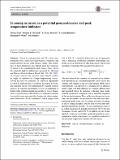| dc.contributor.author | Trail, Dustin | |
| dc.contributor.author | Szumila, Ian | |
| dc.contributor.author | Cherniak, Daniele J. | |
| dc.contributor.author | Watson, E. Bruce | |
| dc.contributor.author | Harrison, T. Mark | |
| dc.contributor.author | Weiss, Benjamin P. | |
| dc.date.accessioned | 2016-11-17T18:18:12Z | |
| dc.date.available | 2017-03-01T16:14:48Z | |
| dc.date.issued | 2016-02 | |
| dc.date.submitted | 2015-10 | |
| dc.identifier.issn | 0010-7999 | |
| dc.identifier.issn | 1432-0967 | |
| dc.identifier.uri | http://hdl.handle.net/1721.1/105339 | |
| dc.description.abstract | Zircon Li concentrations and δ[superscript 7]Li values may potentially trace crustal recycling because continental and mantle-derived zircons yield distinct values. The usefulness of these differences may depend upon the retentivity of zircon to Li concentrations and isotopic ratios. Given the relatively high Li diffusivities measured by Cherniak and Watson (Contrib Mineral Petrol 160: 383–390, 2010), we sought to discover the scenarios under which Li mobility might be inhibited by charge-compensating cations. Toward this end, we conducted “in” diffusion experiments in which Li depth profiles of synthetic Lu-doped, P-doped, and undoped zircon were determined by nuclear reaction analysis. In separate experiments, Li was ion-implanted at depth within polished natural zircon slabs to form a Gaussian Li concentration profile. Diffusively relaxed concentration profiles were measured after heating the slabs to determine diffusivities. In all experiments, which ranged from 920 to 650 °C, calculated diffusivities are in agreement with a previously established Arrhenius relationship calibrated on trace-element-poor Mud Tank zircon. Our revised Arrhenius relationship that includes both datasets is: D[subscript Li] = 9.60 x 10[superscript -7] exp [-278 ± 8 kJ mol[superscript - 1]/RT] m[superscript 2] s[superscript - 1] We also observed that synthetic sector-zoned zircon exhibits near-step-function Li concentration profiles across sectors that correlate with changes in the rare earth element (REE) and P concentrations. This allowed us to examine how Li diffusion might couple with REE diffusion in a manner different than that described above. In particular, re-heating these grains revealed significant Li migration, but no detectable migration of the rare earth elements. Thus, unlike most elements in zircon which are not mobile at the micrometer scale under most time–temperature paths in the crust, Li zoning, relaxation of zoning, or lack of zoning altogether could be used to reveal time–temperature information. Discrete ~10 μm concentration zones of Li within zircon may be partially preserved at 700 °C for tens to hundreds of years, and at 450 °C for millions of years. In this regard, Li zoning in zircon holds significant potential as a geospeedometer, and in some instances as a qualitative indicator of the maximum temperature experienced by the zircon. | en_US |
| dc.publisher | Springer Berlin Heidelberg | en_US |
| dc.relation.isversionof | http://dx.doi.org/10.1007/s00410-016-1238-8 | en_US |
| dc.rights | Creative Commons Attribution-Noncommercial-Share Alike | en_US |
| dc.rights.uri | http://creativecommons.org/licenses/by-nc-sa/4.0/ | en_US |
| dc.source | Springer Berlin Heidelberg | en_US |
| dc.title | Li zoning in zircon as a potential geospeedometer and peak temperature indicator | en_US |
| dc.type | Article | en_US |
| dc.identifier.citation | Trail, Dustin et al. “Li Zoning in Zircon as a Potential Geospeedometer and Peak Temperature Indicator.” Contributions to Mineralogy and Petrology 171.3 (2016): n. pag. | en_US |
| dc.contributor.department | Massachusetts Institute of Technology. Department of Earth, Atmospheric, and Planetary Sciences | en_US |
| dc.contributor.mitauthor | Weiss, Benjamin P | |
| dc.relation.journal | Contributions to Mineralogy and Petrology | en_US |
| dc.eprint.version | Author's final manuscript | en_US |
| dc.type.uri | http://purl.org/eprint/type/JournalArticle | en_US |
| eprint.status | http://purl.org/eprint/status/PeerReviewed | en_US |
| dc.date.updated | 2016-08-18T15:26:48Z | |
| dc.language.rfc3066 | en | |
| dc.rights.holder | Springer-Verlag Berlin Heidelberg | |
| dspace.orderedauthors | Trail, Dustin; Cherniak, Daniele J.; Watson, E. Bruce; Harrison, T. Mark; Weiss, Benjamin P.; Szumila, Ian | en_US |
| dspace.embargo.terms | N | en |
| dc.identifier.orcid | https://orcid.org/0000-0003-3113-3415 | |
| mit.license | OPEN_ACCESS_POLICY | en_US |
| mit.metadata.status | Complete | |
